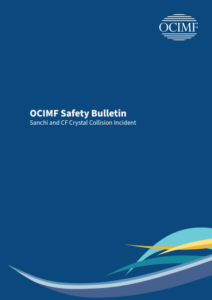OCIMF published a safety bulletin highlighting the importance of verifying the level of awareness and familiarity vessel personnel have with key learnings, procedures and regulations affected by the Sanchi collision.
The Incident
On January 6 2018 the oil tanker named Sanchi collided with the CF Crystal bulk carrier in the East China Sea. Sanchi was transferring condensate oil on voyage from Assaluyeh, Iran to Daesan, South Korea. The CF Crystal, the stand-on vessel, was loaded with sorghum in bulk on voyage from Kalama, USA to Dongguan, China.
The collision between the two vessels led to 32 casualties, out of which three were confirmed dead and 29 declared missing.
OCIMF states that the incident was declared a “very serious marine casualty” as defined in the IMO Code of International Standards and Recommended Practices for a Safety Investigation into a Marine Casualty or Incident (IMO Resolution MSC.255(84)).
Factors that led to the collision
Primary factors
#1 Navigation
- Both vessels failed to comply with Rule 5 (lookout), Rule 7 (risk of collision) and Rule 8 (action to avoid collision) of the COLREGs.
- The Sanchi failed to comply with Rule 15 (crossing situation) and Rule 16 (action by giveway vessel) of the COLREGs.
- The CF Crystal failed to comply with Rule 17 (action by stand-on vessel) of the COLREGs.
- Improper use of Automatic Identification System (AIS) as a navigational/collision avoidance aid.
- Ineffective use of Automatic Radar Plotting Aids (ARPA), radar or other appropriate means to evaluate the developing situation and risk of collision.
- Alteration of course to starboard taken by the CF Crystal (the stand-on vessel) 16 minutes before the collision.
The Chief Officer stated that he made minor alterations of course from 217 to 225 over 9 minutes, with the intention to bring the ship back on-track.
#2 Bridge Resource Management (BRM)
- Evidence that BRM principles such as speak-up and response, ensuring situational awareness, common understanding of collision avoidance options available were not practiced onboard.
- Handover procedures and bridge watch-keeping practices on board the CF Crystal were not robust as the Chief Officer handed over to the watch with a statement that “the traffic was clear”.
#3 Human Factors
- The bridge team manning levels may have been inadequate for the developing situation.
- The decision to call the Master was made too late by the OOW on the Sanchi.
- The advice given/intervention made by the lookout was ignored by the OOW on the Sanchi.
Secondary Factors
#1 Discrepancies between AIS information on Course Over Ground (COG) and Speed Over Ground (SOG) data as received by other vessels compared with what was transmitted from the Sanchi – up to 25 deg in COG and 3 kts in SOG.
#2 Distractions (OOW staying in the chart room and discussing non-navigational matters for a length of time) on the bridge of the Sanchi drove the focus of the bridge team away from their navigational duties.
#3 Reluctance by the OOW on the Sanchi to positively identify and take action for a fishing vessel on the starboard side. The OOW on the Sanchi expected expect smaller vessels to take action even when the Sanchi was the give way vessel.
Lessons Learned
Following the investigation of the incident, OCIMF notes that AIS and ECDIS are additional ways to ensure safe navigation and assist situational awareness. In other words, they should not replace the use of established navigational procedures such as Radar/ARPA and visual bearings for the purposes of collision avoidance.
Moreover, the use of electronic aids to navigation does not mean that the OOW is released from their responsibilities of complying with the COLREGs at all times and using all other available means to judge navigational situations.
Concluding, awareness and familiarity with procedures for backing up Voyage Data Recorder (VDR) information – the limitations of VDR and associated procedures for backing up VDR data should be fully understood and practiced so as to ensure that as much relevant data as possible is available post-incident.
This ensures that the causes and learnings from all incidents are extracted to the fullest extent possible.
Overall, the collision marks the importance of complying with the COLREGs and adhering to navigation best practices and procedures. OCIMF recommends that the bridge team should have a high level of awareness and familiarity with navigational aids and other bridge equipment.
To learn more about OCIMF’s safety bulletin click herebelow


































































